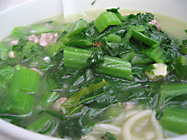Selection and storage
Mustards are winter crops. In the markets, look for fresh mustard greens featuring crispy, dark-green leaves that should show vitality. Avoid sunken, spotted, or yellow, discolored leaves.
Its leaves wilt soon if kept at room temperature; therefore, should be stored in the refrigerator immediately. Although they can be kept for up
to three days in cold storage, fresh mustard greens should be used as early as possible to get maximum nutrients.
Preparation and serving methods

|
| Mustard green soup, a Chinese delicacy. (Photo: by taste-buzz) |
Fresh mustard leaves, flower buds, and stems can be used in a variety of cuisines all over Asia and in Eastern Europe.
Before cooking, wash its leaves thoroughly in clean running water to remove sand and soil, and then rinse in saline
water for about 30 minutes in order to remove surface dirt, and any insecticide residues. Trim away thick petioles and stems.
Here are some serving tips:
-
Fresh tender mustard greens can be eaten raw in salads and can be juiced with other greens and vegetables.
- In South Asian cuisines, mustard is generally stew fried or steam cooked and mixed with other greens such as spinach, fenugreek, etc. Its pungent, peppery flavor is somewhat tamed by adding butter, tomato, garlic and onion to the recipes.
-
It also complements well with ham, pork, and bacon in cooking.
Safety profile
-
As in spinach, reheating mustard green leftovers may cause the conversion of nitrates to nitrites and
nitrosamines by certain bacteria that thrive on prepared nitrate-rich foods. These toxic compounds may be harmful to health. -
High phytate and dietary fiber content in mustard greens may interfere with the bioavailability of iron, calcium, and magnesium.
-
Because of its high vitamin-K content, patients taking anti-coagulants such as warfarin are encouraged to avoid this food since it increases the vitamin-K concentration in the blood, which is what the drugs are often attempting to lower. This may advertently raise the effective dose of the drug.
-
Mustards contain oxalic acid, a naturally occurring substance found in some vegetables, which may crystallize as oxalate stones in the urinary tract in some people. It is, therefore, people with known oxalate urinary tract stones are encouraged to avoid eating vegetables belonging to the Brassica family.
-
Mustard greens may also contain goitrogens, which may interfere with thyroid hormone production and can cause thyroxin hormone deficiency in individuals with thyroid dysfunction.
(Medical Disclaimer: The information and reference guides on this website are intended solely for the general information of the reader. It is not to be used to diagnose health problems or for treatment purposes. It is not a substitute for medical care provided by a licensed and qualified health professional. Please consult your health care provider for any advice on medications.)
You may also like to read >>-
-
≻≻-Mizuna nutrition facts.
-
≻≻- Broccoli rabe Health benefits.
-
≻≻- Komatsuna (Japanese mustard spinach) Health benefits.
≻≻-Back to Vegetables from Mustard greens nutrition. Visit here for an impressive list of vegetables with complete illustrations of their nutrition facts and
health benefits.
≻≻-Back to Home page.
Further reading:
-
Refer Stanford School of Medicine Cancer information Page- Nutrition to Reduce Cancer Risk (Link opens in new window).

